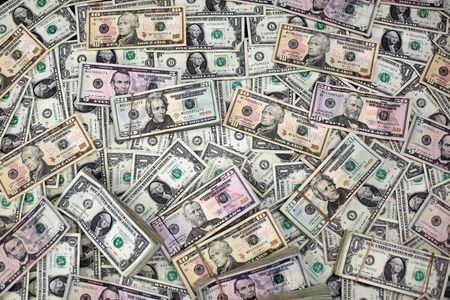By Dhara Ranasinghe and Amanda Cooper
LONDON (Reuters) – The dollar, one of the world’s safest places to park money in times of turmoil, has been shunned by investors as an option for now as uncertainty over tariffs and concern over their impact on U.S. growth intensify.
U.S. President Donald Trump announced far broader and bigger tariffs on Wednesday on roughly 60 countries, including massive tariffs on China and its largest trading partners.
The dollar slid broadly while other safe havens rallied as equity markets shuddered at the tariff news.
Here’s a glance at where the dollar stacks up against other common safe havens.
1/ GREENBACK TAKES BACKSEAT
The dollar has lost its shine as a chief safety option primarily because of the home-grown turmoil unleashed by Trump tariffs that have heightened the risk of a U.S. recession.
While the dollar typically rallies when the S&P 500 stock index falls, both have fallen recently, in a sign the greenback is not benefiting from safe-haven flows.
“I have for a long time held the view that the dollar, yen and Swiss franc are the three main safe-haven currencies, and now I am starting to change that view”, said Russell Investments head of currency and fixed income strategy Van Luu, referring to the dollar’s recent performance.
The dollar index has shed nearly 4% this year and had the worst start to a year since 2016, LSEG data shows.
“It seems investors have yet to fully price in recession risks, allowing dollar weakness to persist as capital rotates out of U.S. assets amid fading economic exceptionalism,” said Rong Ren Goh, a portfolio manager in the fixed income team at Eastspring Investments in Singapore.
But while Trump’s fast-and-loose economic policymaking has hurt confidence in the dollar as the default safe haven, some investors reckon it may regain appeal eventually as global growth suffers.
2/ GOLDEN HISTORY
Gold’s role as a safe-haven asset predates any financial system.
It tends to rise heading into periods of market crisis as investor anxiety mounts – the 1970s energy crisis, the 1980 U.S. recession, the 2007-08 global financial crisis and the 2020 COVID pandemic have all been marked by a rise in the value of gold.
Now, gold has exploded to all-time highs above $3,000 an ounce, having almost doubled in the past 2-1/2 years alone.
Central banks, portfolio managers and retail investors alike have scooped up gold as a hedge against the inflation spike that stemmed from the COVID crisis and then from the global energy crunch. But they kept buying even as inflation eased. And with Trump’s increasingly isolationist policies playing out, many have been buying gold as a liquid alternative to the dollar.
3/ FIGHTING BACK
Japan’s yen is perhaps the biggest major currency to benefit from safety-seeking flows and typically performs well when stocks falter.
The yen was set for its best day against dollar on Wednesday since September and has rallied almost 7% so far this year, while another safe-haven favourite, the Swiss franc, has gained over 4%.
“The yen gains when the S&P is volatile so that’s one thing we have been thinking more about tilting towards,” said Justin Onuekwusi, chief investment officer at investment firm St. James’s Place.
4/ GET DEFENSIVE
Recessions and financial crises tend to hit stocks hard. Investors take profit, yanking their cash as they run for shelter. But most cannot abandon the equity market entirely, so when trouble hits, they tend to pile into stocks whose earnings will theoretically weather recession well, such as drugmakers, utilities and food and beverages.
In the last 25 years, so-called defensive stocks have outperformed cyclical stocks – those more closely linked to the global economy, such as technology or mining shares – every time.
Even now, with no recession immediately in sight, a basket of global defensive stocks has fallen less since Trump’s November election win than a basket of cyclicals, which had been pumped up by pricey tech and AI stocks, reflecting investor caution.
5/ BETTING ON BONDS
Renewed tariff anxiety, for now at least, alleviates selling pressure in government bonds that typically benefit from safe-haven flows amid global stress.
Germany’s benchmark 10-year Bund yield, which has risen on expectations that a surge in German spending will increase bond sales, has fallen from almost five-month highs hit last month.
U.S. 10-year Treasury yields, down more than 10 basis points on Wednesday alone, are on track for their biggest weekly drop in five weeks.
For sure though, not all of that has been driven purely by a bid for safety. Tariff worries have also raised recession risks and the chances of further global interest rate cuts – a backdrop that typically benefits bonds.
“I still expect that this self-created chaos is designed to create panic, and the uncertainty drives yields down at the time when demand for our debt is high, allowing us to refinance about $4 trillion to $5 trillion at much better rates,” said Eric Clark, portfolio manager at Alpha Brands in San Diego, referring to U.S. government debt.
(Reporting by Dhara Ranasinghe and Amanda Cooper in London and Vidya Ranganathan in Singapore; Editing by Hugh Lawson)











